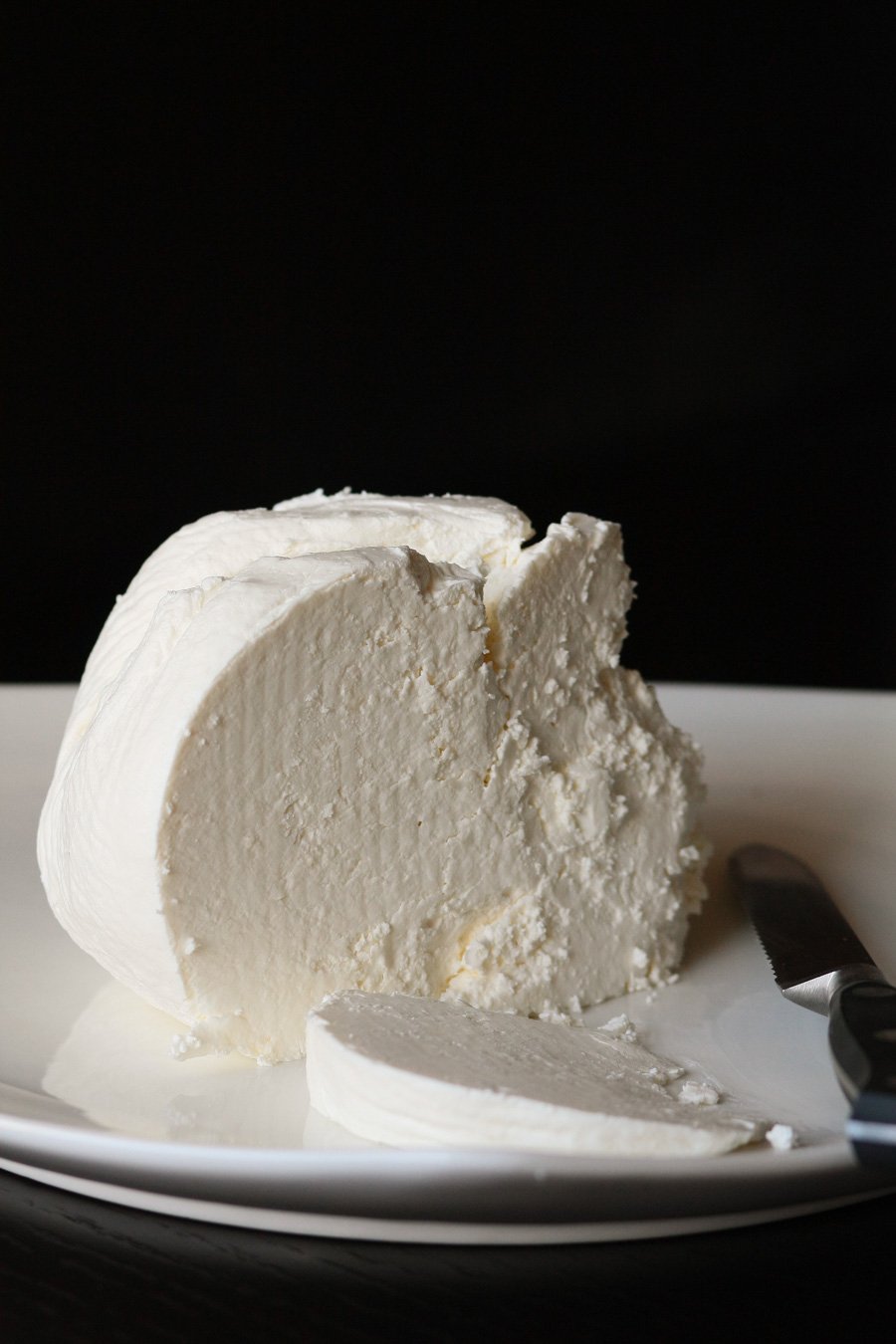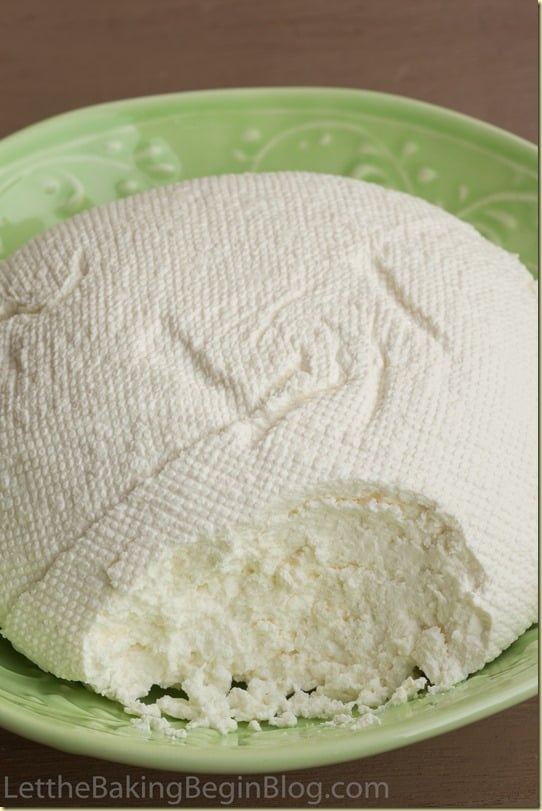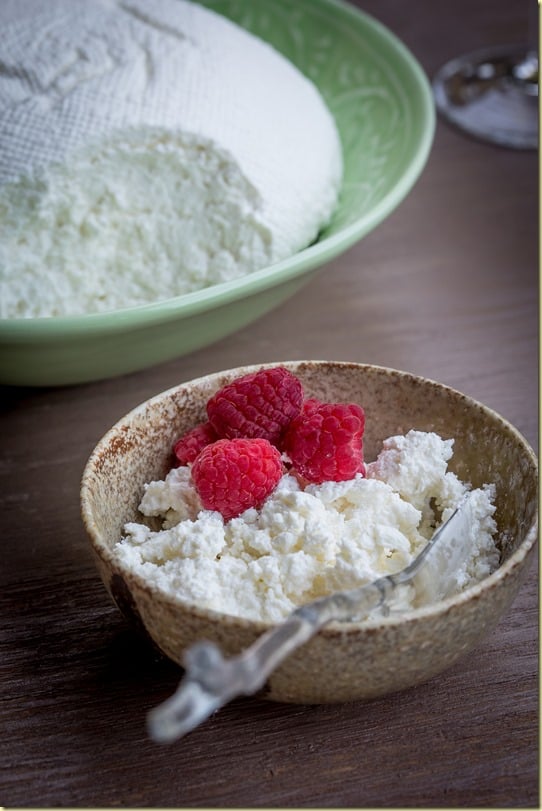Farmer’s Cheese Recipe (Tvorog)
Farmer’s Cheese (Tvorog) recipe is made with just two ingredients which make the loveliest, white, unaged, ricotta-like cheese. You can eat it like you would greek yogurt for breakfast, or use it to make desserts and cheesecakes and these lovely syrniki pancakes (they’re the best!).
What is Farmer’s Cheese?
Farmer’s cheese is a fresh, unripened, cottage-cheese type of cheese that is made with milk and some sort of a bacterial starter. Sometimes rennet is added to help further thicken the mixture before heating and draining it, but that’s not common when making it at home.
Type of Bacterial Starters that make Farmer Cheese
The bacterial starter can be in a form of yogurt, buttermilk, greek yogurt, sour cream or actual kefir grains. Each type of starter will give you a different variation of flavor and amount of tang, while still producing a very similar farmer’s cheese flavor in the end.
How to eat Farmer’s Cheese?
- Drizzle some cheese with honey or some cherry sauce, then sprinkle with chia seeds.
- Top a buttered toast with a spoonful of cheese and a sprinkle with sea salt for a protein full breakfast.
- Add a spoonful of this homemade cheese to your omelet or scrambled eggs.
- Substitute ricotta cheese with this farmer’s cheese and make pancakes for breakfast.
- Or make the true Russian pancakes (Syrniki) with it for a protein packed breakfast.
- Use farmer’s cheese in place of ricotta cheese to make doughnuts.
- Combine this cheese with salt, egg yolk and herbs like dill and parsley and fill Piroshki or Perogies with it.
- Combine the cheese with some freshly made pasta, then add some heavy cream and sugar for a sweet dessert pasta recipe.
Method for How To Make Cheese
I used to use cheesecloth to collect the curds and allow the whey to drip off, but I have always hated the clean up afterward. Now I use paper towel lined sieve to achieve the same thing. Clean up is a breeze now as you just take the paper towel and throw it away. I can’t believe I didn’t come up with this sooner.
Tips on making the perfect Cheese
Over the years of making my own Homemade Cheese I have also found that when I heat the buttermilk, dump it straight into the cheesecloth and hang it, it takes forever for the whey to separate, because all the curds have broken up and mixed in with the whey.
Lately though, after I heat the buttermilk, I use a scoop colander (any other colander with large holes and a handle will work) to gently remove the curds, then I give it a shake to remove most of the whey and lastly I transfer the now whey-less curds to the paper towel-lined sieve, the cheese does not need more than an hour before all whey has dripped off. The cheese is then ready for consumption.
What is your favorite way of eating homemade Cheese?
There are many different ways to eat/use this cheese recipe. This homemade cheese is great to use as a filling, or just eaten as is. What do you eat Farmer’s cheese with?
Some great Farmers Cheese Recipes:
- Multi-Cooker Farmer’s Cheese – Cheese made in a Multi-Cooker.
- Farmer’s Cheese Crepes with Blueberry Sauce – A delicious way to use farmers cheese recipe.
- Apricot Cream Cheese Chimichangas – Crispy fried tortilla with warm jam and farmers cheese.
Keep reading on how to make cheese!
Homemade Fresh Farmer's Cheese

Homemade Fresh Farmer’s Cheese (Tvorog) recipe made with buttermilk and milk. A simple how to make cheese recipe. This Farmers Cheese is served great with honey or used as a filling.
Ingredients
Ingredients for Homemade Farmer's Fresh Cheese
- 1 gallon whole milk
- 1-2 cups Dairy Gold Buttermilk or other buttermilk
Utensils:
- Large Heavy Bottom Pot
- Cheesecloth or Paper towels
- Food thermometer
- Sieve
Instructions
*Read complete post before the recipe to get a better understanding of how and why you do what you need to do.
-
Pour 1 gallon of milk into a large heavy bottom pot and heat it to 100F. It should feel slightly hotter than warm. (Do not make it hot, or it will kill the buttermilk culture.) Remove from heat.
-
Shake the bottle with buttermilk, then pour 1-2 cups into the warm milk. Stir for about 1-2 minutes.
-
Cover with lid and allow to sit at room temperature, undisturbed for 12-24 hours depending on how warm it is. If the room temperature is below 70, place pot of warm milk in the oven with just the light on (NO heat).
-
Buttermilk is ready when it’s thick and you’re able to ‘cut’ it with a spoon, that means when taking a spoonful of buttermilk, it doesn’t run like milk but holds its shape. (When in doubt, leave it for full 24 hours.)
-
Cut the buttermilk into 1-inch squares with a long knife.
-
Insert a thermometer into one of the curds and start heating over very low heat. It will take about 15 minutes to reach to 120°F. This is what it will look like when it’s heated to 130°F.
-
Make sure the thermometer is inserted into the curd, not the whey. Whey around the curds might even start boiling because it’s of less density than the curds. When temperature inside the curd reaches 100°F, give a gentle stir with a large spoon and bring the hot curd from the bottom to the top. It only needs to be heated another 30°F-40°F degrees before you will need to drain it. You will see both cheese-like chunks and big curd chunks, that’s ok, that’s how it’s supposed to be.
-
Once the temperature inside the curd reaches 130-140, give it another gentle stir, to break up large curd chunks and to distribute the heat evenly.
Option 1
-
Carefully pour the heated curds to a different pot lined with a cheese-cloth, then gather the ends of the cheesecloth, tie them and hang over the kitchen cabinet door handle or some other device. Allow the whey to drip off, until droplets fall about 30 seconds apart. At this point, transfer the cheese with the cheesecloth to the refrigerator. It will harden up and it will be easier to remove the cheesecloth without ruining the cheese ‘ballthe
Recipe Notes
To make homemade buttermilk, do not heat like you would to make fresh cheese, but vigorously stir, transfer to a jar and store in the refrigerator.
Thank you for following me on Instagram, Facebook & Pinterest!
Hashtag your photos #LetTheBakingBeginBlog so I can see your creations and for a chance to be featured!















Very unreliable recipe. I had the same experience as a person further back in the comments, after a whole 24 hours, my milk still hadn’t stiffened up and seemed more like yogurt. Dissapointing because I spend extra on nice local milk and buttermilk. I’m going to just proceed and see how it goes but I don’t have “curds” and “whey,” it’s all pretty mixed together like yogurt so I don’t know how I’m going to properly measure the temp. Every other recipe I’ve seen seems way easier using vinegar instead of buttermilk and I’m probably going to try that method next.
Hi Mary,
As with any fermented process the results heavily depend on the milk and your particular environment, so the process might need to be adjusted to account for those.
I’m not sure what milk and buttermilk you used, but different brands will produce different thickness yogurt once the fermentation process is completed. The one I mentioned in my post produces the thickness you see on the picture. Other brands (our local Costco milk for example) produce thinner, almost buttermilk-like consistency. Even with that consistency though, once heated you’ll be able to get good farmer’s cheese. Just take care not to heat it too much or the cheese will be rubbery. It might take you several times to adjust your process/temperature to fit your desired end result.
The cheese made with just lemon juice/vinegar does not taste anything like the true farmer’s cheese. If you don’t particularly care for the tang of the farmers cheese nor the probiotic benefits, and instead just want something that is more of ricotta flavor (flat/milk flavor) with farmer’s cheese texture then the vinegar option is definitely the way to go. But, the two are not the same in flavor. Just keep that in mind.
Hope this helps!
I may have heated my milk too much before adding the buttermilk; it was 120 degrees (I got it mixed up with a different recipe). Is my buttermilk culture dead?
Hi Marina! I heated it to 100 degrees before I put it in the oven. I waited 24 hours and it looked thick. I cut it in cubes and started warming it up on low heat. Everything looked fine until I started straining it and it started oozing. Looked like yogurt. So I let it sit and drain some more. It was sitting on the kitchen counter for like 24 more hours. I kind of gave up. This evening I came just to check on it and it was fine. It looked it it finished its process on its own. So I put it away and will be Making crepes. It’s very delicious.
The only thing that I wasn’t sure about is this:
Do you only check the temp in one place or multiple places to make sure the temp is at 130 or 140 degrees. It might have been perfect when I checked in one section but didn’t heat thru in another. Can you provide more on this.
Hi Marina I used Darigold Bulgarian style buttermilk and Lucerne Dairy Farms whole milk. I used the recipe precisely. Let it sit in the oven for full 24 hours. I used food thermometer to get it to 140 degrees. When I took the curds and put it in a cloth to drain it didn’t turn the way it was supposed to. It’s more of a yogurt what came out.
Please help. I need to be able to get this recipe to work. We use a lot of cottage cheese and I want to have a good recipe on hand
Let’s see if I can get more info in order to help.
Did you heat it before placing it in the oven for 24 hours?
What did it look like after the 24 hours? What kind of texture was it?
When you heated it to 140 did it curdle into curds?
When you say that it’s more of yogurt when it came out, you mean it just oozed through the cheesecloth and became like yogurt, or what do you mean?
Hi Marina
Is there a brand of milk that you like to use? I heard that some brands work better than others. I never made this before and want to succeed. Please help
Really like this recipe, thank you! When heating thru after it has stood 24 hours I have found it easiest to just let the whey heat up to 120 or 130 degrees, turn it off, take it off the heat and let it stand 15-20 mins. That way there’s no babysitting the curd temp, if that makes any sense. My fav thing to do with farmers cheese is to mix it with one package of softened cream cheese, sugar to taste and use it in different recipes. So delicious! Also it freezes well (without any other ingredients added)
This looks great! Have you ever tried making it in the Instant Pot? Looking for a good alternative.
Thanks Katerina! Check this out 😉 https://letthebakingbegin.com/multi-cooker-farmers-cheese/
Oachen’ khorosho! Svobodno! Been trying different recipes for farmer cheese for many years. This one has ended my search! I need it to fill german kasekuchen and for Easter paskha. Thank you very much. Bud’te zdroviy.
That’s so awesome to hear! Thanks so much for your kind words!
Marina
Made my first homemade cheese and realized there is nothing better than what I ve tasted!!!
Didn’t have buttermilk mentioned in the recipe, so ended up having yogurt like consistency. Anyway, followed the instructions and got the cheese.
My 2 year old baby loves it like lazy cooked dumplings with cooked onions and bacon crumbles.
Thanks Marina! Your recipes are rocking!
Do you suggest using room temperature milk and buttermilk? thanks!
Since we will be heating both, it doesn’t matter if it’s room temperature or not. It will just heat faster if it’s room temperature to begin with.
Can I use whole milk and substitute buttermilk for active plain yogurt instead and how much?
Will I get cheese or some kind of yogurt?
Yes you can. Using different kind of culturing agent (yogurt/buttermilk etc.) will produce different texture of the cultured milk, but once you heat it and drain it, it will still make farmer’s cheese.
When using yogurt, I would use at least 1 to 2 cups yogurt per gallon of milk.
But if you did want to make yogurt, you would heat the milk, stir in yogurt and let it sit at room temperature until it’s thickened – that’s it.
To make cheese, you heat this yogurt until the whey separates from the curds.
Hi Marina,
I live in MN and am not familiar with dairygold buttermilk. Do you know of anything else I could use that would work as well? -Ally
Organic Valley has buttermilk and it’s from Wisconsin. That’s what I am planning to use to make cheese.
Would it work to use goats milk? Is there a goat buttermilk?
I can’t think of why it wouldn’t, but can not guarantee success since I have not done it myself.
I didn’t have that brand of buttermilk at my store. My milk mixture has been on the counter over 24 hours now and it’s not thick enough to cut. I just read through the comments and saw the buttermilk needs to have live cultures so I checked mine and it doesn’t say that it has those. 🙁 Any idea what I should do?? It’s the consistency of regular yogurt right now. ~christine
If it’s thickened to yogurt consistency just start heating it over low heat and stirring it about every 7-8 minutes until you see curds form. When you see cheese curds form, stir a little bit more (follow the guide with the temperature in the recipe), then allow to cool and follow with the rest of the recipe. While it’s easier to figure things out when you use the mentioned buttermilk, it will still work with other buttermilks. I am just not a fan of that consistency that’s why I go with the one I mentioned in the post. Let me know how it all goes.
Is this truly cheese or more like a glorified yogurt? What’s the taste like?
Thanks for the tutorial, this is really interesting.
Hi Tina, Thanks for the question! It’s definitely not glorified yogurt. It has the consistency of ricotta cheese, but it’s not as bland as ricotta, because it has the tang of a yogurt.
I use leftover whey to make russian pancakes… just add a lil baking soda, flour, and sugar… they are amazing
That’s a great idea Diana! Thank you!
I use leftover whey as a substitute for the liquid when I make bread or buns. The bread tastes a little like sourdough but is absolutely delicious.
What a great idea for using the whey! Thank you for sharing!
The images are beautiful! It looks delicious! Thank you for sharing Marina. Glad to hear our buttermilk works well 🙂
Oh thank You! I’m happy your buttermilk works for my cheese 🙂 thank you for making it!!
Marina, THANK YOU for this recipe! I wonder if the fatter buttermilk is better (like that Darigold 3.5% Buttermilk instead of a low fat 1% one)
No problem Marina! Milk with higher fat content does produce more delicious cheese and yields more cheese, as well, but because there’s such small amount of buttermilk being added to the milk, I doubt it makes much of a difference on the flavor.
This cheese is really beautiful! I cannot wait to make it. My Mom used to make cheese similar to this and I remember loving it!
Thanks Caroline!
Whole milk or raw milk? Isn’t most milk pasturized? What do you recommend if Dairy Gold buttermilk isn’t available.
Whole milk. In this recipe pasteurization does not negatively affect final product. If Dairy Gold is not available, just look for buttermilk that contains live cultures, and then experiment with different brands for the best quality, but as long as it has live cultures it will work.
Where is the recipe for that nut & seed bar lying below the dish of cheese w/ raisins in that photo? Looks delicious! 🙂
Also, I make raw, organic yogurt with my Probiotic 11. How would I do it differently to make buttermilk, but still raw & w/ my culture?
I also have some Kirovskaya Russian kefir grains. Can I use kefir in place of the buttermilk?
Can I make tvarog raw? I make a raw yogurt cheese but it comes out more like a cream cheese.
🙂
Thanks for the great recipes.
Sorry, the nut and seed bar was purchased from the store, not something I made 🙁 I bought it at the Russian store, by the way.
Anything that has live and active cultures will be a good replacement for buttermilk, as it will do the same exact job.
To make tvorog you need to heat the cultured milk to about 110F – 120F, it’s well below the boiling point but still uses heat. There’s not way to make tvorog with unheated milk. The cultured milk curdles to the right consistency (of tvorog) only when heated. You can make cream cheese consistency cheese with completely raw milk, but not the tvorog consistency.
Yummy!!! I love tvorog any where in any foods. I always wanted to try making it with buttermilk. Thanks for the recipe Marina 🙂
I wonder if you’ve tried it yet 🙂
Marina! thank you so much for this recipe. I just discovered your blog today you are awesome!!!!! I browsed all of your recipes cant wait to try some of your creations.
Thank you Galina!
This cheese is gorgeous! Love the photos where honey is dripping and where cheese is mixed with raisins – I want that for breakfast.
Thank you! I actually took pictures two separate times because I wasn’t sure I liked the cheese where it’s mixed with raisins)) in the end I included photos from both times 🙂
Where is the recipe for that nut & seed bar lying below the dish of cheese w/ raisins in that photo? Looks delicious! 🙂